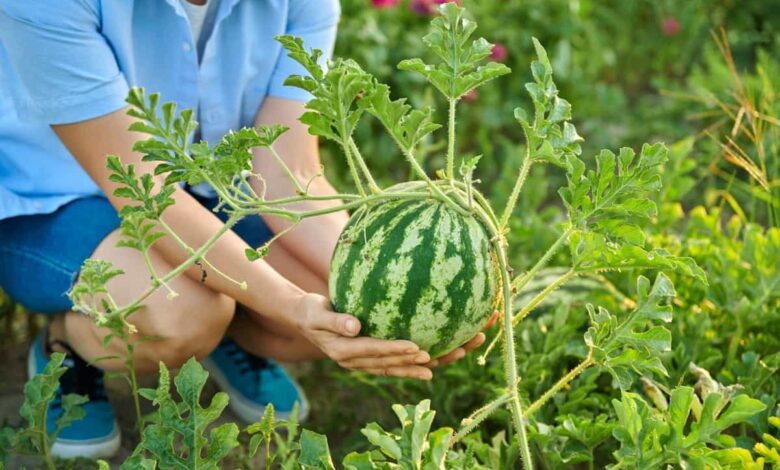Watermelon Cultivation: The Essential Fruit for Summers

The most demanding fruit in summer is watermelon. It is well-known for its potential to cool the body due to its high water content and cooling qualities. This fruit is also a good source of vitamins such as Vitamins A and C. Also, it offers essential antioxidants that boost immune system function and promote skin health.
Health Benefits of Consuming Watermelon
Watermelons are best for beating the heatwave during the summer seasons. Along with, they have lots of health benefits, let’s explore them:
- Hydration
- Good source of Nutrients
- Antioxidants properties
- Improves digestion
- Muscle recovery
- Good for heart health
- Anti-inflammatory benefits
- Weight management
- Improves skin health
- Manage blood sugar
- Improves kidney function
- Aids eye health
- Cancer prevention
- Boosts immune systems
- Improves hair and nail growth
The Basics of Watermelon Cultivation
A healthy and fruitful crop of watermelon is ensured by a number of crucial procedures in the cultivation process. First, choose the variety that will grow best in your climate and soil. Followed by ideal growth circumstances, planting, and germination. Let’s explore these in detail.
Choosing the Right Variety
It’s important to pick the right variety of watermelon. Some common selections are the seedless Sugar Baby and Crimson Sweet. These are highly prized for their sweetness and low chances of disease. For the best quality and yield, the decision is based on soil characteristics, climate, and market needs. There are a number of varieties you can choose from; here is the list below:
- PAN 2053 Spl hybrid watermelon seeds
- Pakeeza watermelon
- Arun 0035 watermelon
- IRIS hybrid fruit seeds watermelon
- URJA US-888 watermelon F1 Hybrid seeds
- Apoorva watermelon
- Anmol yellow watermelon
- AFA 306 watermelon
- NS 295 watermelon
Perfect Growing Conditions
Warm, sunny temperatures are great for watermelons’ for their growth. They need soil that is sandy loam, well-drained, and has a pH of 6.0 to 7.5. For the healthy development of watermelons, correct soil preparation using organic matter and well-balanced fertilisers is very important.
Land Preparation
First things first: choose a land with well-draining, organic matter-rich sandy loam soil for producing watermelon. After using a Cultivator to remove weeds and waste from the soil, deeply plough the surface to improve aeration.
Furthermore, farmers may improve soil fertility by adding compost or well-rotted compost. If needed, they can apply lime to the soil to maintain its pH level. They can also construct lifted beds or slopes to enhance drainage and avoid standing water to prevent root rot.
Lastly, irrigation furrows should be created to provide a steady supply of water throughout the growing season.
Planting and Germination
To start the planting process, prepare the soil with the help of a Rotavator. A rotavator is an agricultural equipment used to prepare the soil for planting and cultivating crops. Its revolving blades break up, churn, and aerate the soil, all of which can enhance crop output and soil health.
Early summer and late spring are the perfect times to plant the watermelon seeds. Plant the seeds about an inch deep, leaving enough space between them for the vines to expand. Germination takes place within a week, preparing the way for quick growth.
For germination, the perfect moisture content and sowing temperature range is between 18 and 25°C. A temperature range of around 35 to 40°C is excellent for the growth of high-quality, sweet fruit. While a typical temperature of 30 to 35°C is needed for growth.
Irrigation
Water your newly planted seedlings as soon as possible and then again every two or three weeks after that. Particularly, don’t overwater them when it’s blooming or fruiting. Make an effort to water the roots only—not the blooms or foliage.
For delicious and sweet watermelons, stop watering them entirely a few days before harvesting. The drip irrigation method is best for watermelon cultivation, which conserves water and reduces illness. Throughout the season, you should usually water your watermelon plants seven or nine times.
Pest Management
Weeds fight with watermelons for nutrients and moisture, which is why constant weeding is necessary. Aphids and beetles are among the common pests that may be controlled with comprehensive pest control techniques. This includes the use of organic insecticides and natural predators.
Harvesting
Check the time first; it’s normally ready a month or so after the flowering appears. Notice the curling tendril next to the stem. It’s a positive indication if it has dried out. Another option is to tap the watermelon lightly. It’s ready to pluck if it sounds hollow and dull.
The coloured part of the melon’s portion that touches the ground is another method to make sure. Everything is OK if it has turned a pale yellow colour. Lastly, attempt to press your thumbnail into the skin. When the fruit is too thick to pierce and cannot be broken, it is fully ripe!
Conclusion
In conclusion, watermelons are easy-to-grow summer fruits that taste well and are rich in vitamins and antioxidants. By understanding these above steps, you can grow watermelons efficiently.
The right equipment, such as rotavators, cultivators, and tractors — a major part of farming—can make your farming process more efficient. Nowadays, it’s very easy for farmers to purchase tractors with a Tractor Loan.



